Introduction
Within This Page
Global climate change, caused by the emissions of greenhouse gases (GHGs) that trap solar heat in the Earth's atmosphere, has major impacts on both people and the environment. Nearly 40% of GHG emissions are attributed to the design, construction, and operation of buildings. As the majority of GHG emissions are from fossil fuel use, reversing climate change requires the reduction of building energy use and transition to renewable energy sources. To achieve these reductions, an overview of greenhouse gases, various benchmarking and reduction strategies, and applicable Federal regulations and legislation are addressed in this page.
Description
A. Overview of Greenhouse Gases
Greenhouse gas refers to any gas that traps heat in the atmosphere through the greenhouse effect. Some GHG emissions are the result of both natural occurrences and the result of human activities, while others are exclusively emitted through human activities. Those emitted exclusively through human activities are known as anthropogenic gases, and they are the main focus of GHG reduction efforts. The principal greenhouse gases are:
-
Carbon Dioxide (CO2) Although trace quantities are found naturally in ambient air, the emission of this gas is primarily from fossil fuel combustion from activities including electricity generation, transportation, manufacturing (e.g., cement), and municipal solid waste combustion. Carbon dioxide concentrations in the atmosphere have risen by almost 35% since the Industrial Revolution.
-
Methane (CH4) is emitted during the production and transport of coal, natural gas, and oil, from the decomposition of organic wastes in municipal solid waste landfills, and from the raising of livestock. It is also released during normal coal mining operations and wastewater treatment especially from municipal sewage systems. It remains in the atmosphere for 9–15 years and is over 20 times more effective in trapping heat than CO2 over a 100-year period. Methane is also a primary component of natural gas and can be an important energy source, as through the use of natural gas or the trapping of landfill methane. Methane concentrations in the atmosphere have risen by over 150% since the Industrial Revolution.
-
Nitrous Oxide (N2O) has a long atmospheric lifetime of approximately 120 years and a heat trapping effect that is almost 310 times more powerful than carbon dioxide on a per molecule basis. Nitrous oxide is emitted during agricultural and industrial activities, as well as during combustion of fossil fuels and solid waste. In relation to building inputs and outputs, N2O is emitted during wastewater treatment and during the production of adipic acid, which is used to create some plastics and urethane foams; however, this is a fraction of the emissions from agricultural and industrial activities. Nitrous oxide concentrations in the atmosphere have risen by over 16% since the Industrial Revolution.
-
Fluorinated Gases include artificial greenhouse gases such as hydrochlorofluorocarbons (HCFCs), perfluorocarbons, and sulfur hexafluoride. They remain in the atmosphere for various lengths of time ranging from tens to thousands of years and can be thousands of times more effective in trapping heat than CO2 over a 100-year period. They are primarily emitted from industrial processes and are used as substitutes for ozone depleting substances. As it relates to buildings, these gases are emitted through electrical transmission and distribution and through supply chain use in refrigerants such as R-22, insulation, and halon fire suppression systems. Although they are emitted in much smaller quantities than the other gases, because of their high potency they are often called High Global Warming Potential Gases.
-
Chlorofluorocarbon (CFCs) are greenhouse gases, although they are considered a more serious factor in regard to ozone depletion rather than global warming. CFCs were defined by the 1987 Montreal Protocol and are used for refrigeration, air conditioning, packaging, insulation, solvents, or aerosol propellants—all of which are commonly used in buildings. These gases are being replaced by other compounds, including hydrochlorofluorocarbons and hydrofluorocarbons, which are greenhouse gases covered under the Kyoto Protocol. For details on the Montreal Protocol and Kyoto Protocol see the below subsection on the different protocols.
The following units of measurement have been developed to compare the different greenhouse gases:
-
Global Warming Potential (GWP)—is a measure of how much a given mass of greenhouse gas is estimated to contribute to global warming. It is a relative scale that compares the gas in question to that of the same mass of carbon dioxide (CO2) whose GWP is, by convention, equal to 1. A GWP is calculated over a specific time interval that must be stated whenever a GWP is quoted or else the value is meaningless.
-
Carbon Dioxide Equivalent—Emissions of greenhouse gases are typically expressed in a common metric so that their impacts can be directly compared, as some gases are more potent and have a higher global warming potential than others. The international standard of practice is to express greenhouse gases in carbon dioxide equivalents.
The following table shows the typical atmospheric lifetimes and GWP of different gases relative to Carbon Dioxide.
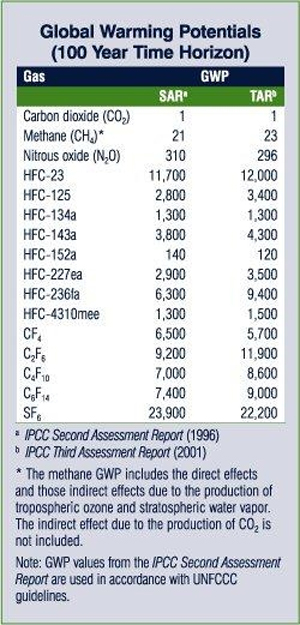
The following figure shows the typical breakdown of all GHG emissions in the U.S. by the major GHGs relative to Carbon Dioxide—i.e., CO2 Equivalents.
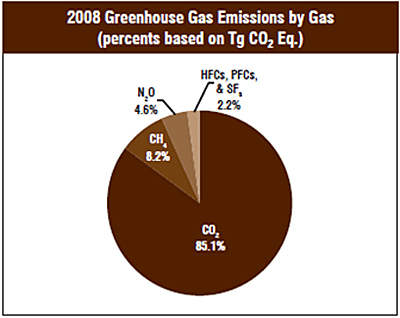
* Carbon Dioxide (CO2) has a variable atmospheric lifetime, and cannot be specified precisely. See the EPA's Glossary of Climate Change for more information.
Image courtesy of the EPA Inventory of U.S. Greenhouse Gas Emissions and Sinks: 1990-2008.
GHG emissions are defined and or regulated by two international treaties, the Montreal Protocol and Kyoto Protocol. The third, the Greenhouse Gas Protocol was developed by the World Resources Institute (WRI) and the World Business Council for Sustainable Development, which are not for profit organizations.
-
Montreal Protocol—The Montreal Protocol on Substances That Deplete the Ozone Layer is an international treaty designed to protect the ozone layer by phasing out ozone depleting substances, many of which are also greenhouse gas emitters. Such substances include CFCs and HCFCs. The Montreal Protocol currently calls for a complete phase-out of HCFCs by 2030 and a separate phase-out plan for CFCs. (The goal of the treaty is protection of the ozone layer, although CFCs and HCFCs are greenhouse gases as well.)
-
Kyoto Protocol—is a protocol to the United Nations Framework Convention on Climate Change (UNFCCC or FCCC), aimed at fighting global warming. Signatories to this protocol commit themselves to a reduction of the four main greenhouse gases; carbon dioxide, methane, nitrous oxide, sulfur hexafluoride, and two groups of gases; hydrofluorocarbons and perfluorocarbons. Although the United States signed the protocol in 1998, Congress has not ratified it.
GHG accounting is being further developed based on protocols including Greenhouse Gas Protocol, an international accounting tool for governments and businesses to understand, quantify, and manage greenhouse gas emissions. According to its developer, the World Resources Institute, "The GHG Protocol, a decade-long partnership between the World Resources Institute and the World Business Council for Sustainable Development, is working with businesses, governments, and environmental groups around the world to build a new generation of credible and effective programs for tackling climate change. It provides the accounting framework for nearly every GHG standard and program in the world—from the International Standards Organization to The Climate Registry—as well as hundreds of GHG inventories prepared by individual companies."
GHG emissions are commonly classified into "scopes" based upon the source of the emission and by whether they are either direct or indirect. Direct emissions come from sources that are controlled by the emitter. Indirect emissions are those that are a consequence of the activities of the emitter, but that occur at sources owned or controlled by another entity. These scopes were developed and defined by the WRI as part of their Greenhouse Gas Protocol.
-
Scope 1—emissions are direct GHG emissions from sources that are owned or controlled by the entity. Federal examples include the CO2 emissions from heating plants in Federal buildings, emissions from federally controlled vehicles, and methane emissions from federally controlled wastewater treatment plants.
-
Scope 2—emissions from the consumption of purchased electricity, heat, or steam energy. Federal examples include the CO2, N2O, and fluorinated gas emissions from the generation of electricity at a plant that is not owned by the Federal government, but that sells electricity to a Federal building.
-
Scope 3—emissions encompassing all other indirect emissions such as those related to the extraction and production of purchased materials and fuels, transportation-related activities in vehicles not owned or controlled by the emitter in question, outsourced activities, waste disposal, and all other indirect emissions not covered in Scope 2. Federal examples of these emissions include those related to business travel of Federal employees in non-Federal vehicles, and distribution losses related to electricity transmission to Federal buildings.
Common sources of Federal greenhouse gas emissions are shown in the image below.
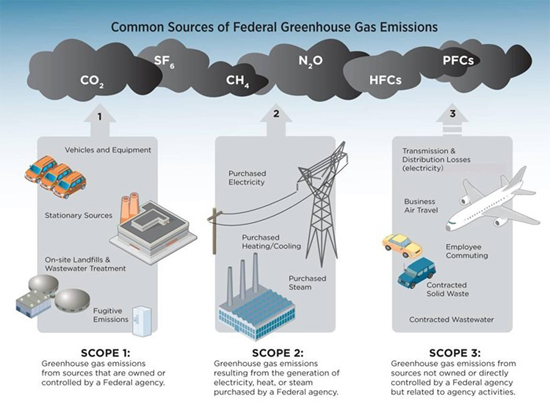
Image courtesy of the EPA
B. GHG Benchmarking Strategies
GHG reduction efforts should be preceded by a benchmarking of the building in question. Benchmarking is essential to identifying the existing or proposed emissions of a building. By benchmarking a building through the use of a GHG emission inventory tool or carbon footprint analysis, it will be possible to identify the largest contributors to a building's emissions and the greatest source of opportunity when it comes to specifying reductions. Executive Order 13834, Section2(h)issued in 2018, requires agencies to report on “report on energy management activities, performance improvements, cost reductions, greenhouse gas emissions, energy and water savings, and other appropriate performance measures.”
One of the most widely used benchmarking inventory tools is the Federal Energy Management Program Reporting Portal. This Excel workbook, released October 6, 2010 by DOE's Federal Energy Management Program (FEMP), provides electronic reporting capability for the Federal agency compiled comprehensive GHG inventory for FY2010 and the base-year 2008 GHG inventory for the purpose of measuring progress. Additionally,Executive Order 13834, Section2(h),— issued in 2018, requires agencies to report on “report on energy management activities, performance improvements, cost reductions, greenhouse gas emissions, energy and water savings, and other appropriate performance measures.”
The tool collects agency-aggregated data necessary for calculating scope 1, 2, and 3 GHG emissions in the commonly-used units of energy consumption and fugitive emissions as well as activity data for estimating scope 3 indirect emissions. It provides users with the summation of their calculated emissions as well as other performance results for other sustainability goals.
Version 6.1 is the most up to date version as of the publishing of this page. See the link to the workbook energy.gov/sites/prod/files/2015/10/f27/annual_ghg_data_report_v6-1.xlsx . The GHG and Sustainability Data Report Demonstration is available here.
A sample screenshot of the results summary from this tool is shown below.
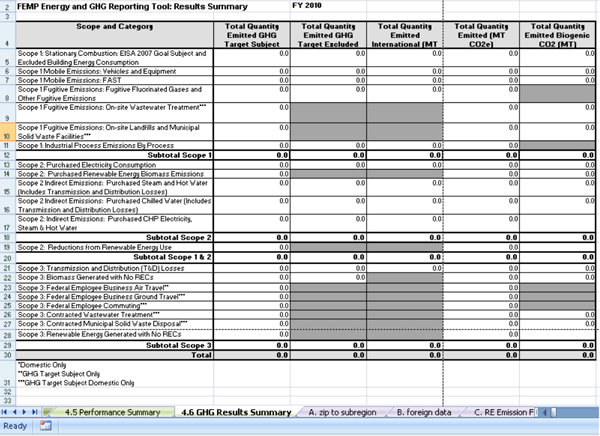
Partial Screenshot of Worksheet 4.6 GHG Results Summary in the FEMP Reporting Portal.
Image courtesy of the workbook available at: www.fedcenter.gov/_kd/go.cfm?destination=ShowItem&Item_ID=16387
Another benchmarking inventory tool is the Electronic Greenhouse Gas Reporting Tool (e-GGRT) which was created by the EPA to support GHG reporting as part of the Greenhouse Gas Reporting Program (GHRP).
To assist federal agencies in calculation and reporting GHG emissions, the Federal Greenhouse Gas Accounting and Reporting Guidance was issued. This Guidance is accompanied by a separate Technical Support Document for Federal GHG Accounting and Reporting (TSD), which provides detailed information on inventory reporting requirements and calculation methodologies. Federal agencies are required to use this Guidance when reporting GHG emissions under E.O. 13514.
Another important resource is the U.S. Greenhouse Gas Inventory Report: 1990–2014. This is an emissions inventory that identifies and quantifies the country's primary anthropogenic sources and sinks of greenhouse gases that is essential for addressing climate change.
C. GHG Reduction Strategies
Strategies to reduce GHG emissions should focus on both scope classification and the specific gases being targeted. Several of these measures are either interlinked and/or contribute to savings across multiple scopes, which is why Scope 1 and Scope 2 reductions will be discussed together below.
-
Scope 1 and 2 Reductions
Whether the following strategies reduce Scope 1 or 2 emissions will depend on the buildings' fuel source—if it uses natural gas or other fuels combusted on-site, energy efficiency and renewable strategies will reduce Scope 1 emissions; if it uses electricity provided through off-site energy generation through fossil fuel combustion (e.g., coal-fired power plants), then these same strategies will reduce Scope 2 emissions. Similarly, whether wastewater treatment and solid waste reduction activities are conducted on or off-site will determine whether reducing GHG emissions from these operations affect Scope 1 or 2 emissions.-
Building Energy Savings Measures
Energy savings measures will result in CO2 reductions as a result of their fuel and electricity use savings. In buildings with on-site generated energy these reductions will fall under Scope 1, and in buildings with offsite generated energy these reductions will fall under Scope 2. -
Federal Vehicles and Equipment Improvements
Federal vehicles and equipment represent tremendous potential for Scope 1 CO2 reductions. Reductions are possible by establishing GHG emission standards for light and medium duty vehicle fleets, as seen in California and other states, optimizing vehicle numbers across agency fleets, and using low GHG emitting and alternative fuel vehicles such as plug in hybrids, which are mandated by Executive Order (EO) 13423. EO 13423 directs Federal agencies to purchase plug-in hybrid vehicles when they are commercially available and life-cycle cost-effective as compared with conventional vehicles. Additionally, petroleum consumption in Federal vehicles should be reduced by at least 2% annually through fiscal year 2020 relative to a fiscal year 2005 baseline. This can be accomplished by using such tools and calculators as provided through the DOE's Fuel Economy. GHG emissions can also be reduced through the promotion of non-vehicular travel such as bicycles and walkways, as well as through the use of local-use vehicles, such as segways, electric scooters and electric 'golf carts' instead of traditional vehicle fleets. Vehicle standards should also be extended to other equipment such as construction equipment, heavy duty vehicles, and airplanes. -
Wastewater Treatment and Solid Waste Reduction
Solid waste reduction efforts such as waste prevention and recycling measures have the ability to reduce Scope 1 and 2 CO2 and N2O emissions. While many Federal buildings are equipped with their own incinerators, reducing the amount of waste combusted at these sites will reduce CO2 and N2O emissions. By diverting materials from the incinerator to an alternative option such as composting, buildings eliminate the N2O GHG emissions and minimize the amount of CO2 they produce. Additionally, in buildings with their own wastewater treatment facilities, these efforts will help to reduce the amount of CH4 released during typical anaerobic operations. Waste reduction efforts in buildings can include composting programs, recycling programs that incentivize or create competitions around the amount of material recycled, and high efficiency and low water toilet fixtures such as dual flush or no flush fixtures. While the last item will reduce the amount of waste water and not waste, any reduction in waste water will have a corresponding reduction in the amount of emissions generated during the treatment of this water. -
HCFC Reductions and Phase-outs
Replacing older refrigeration equipment provides an opportunity to reduce HCFCs and to increase the efficiency of the existing system. One way to reduce emissions is to replace R-22 refrigerants in equipment with R-410A. This will also result in Scope 3 reductions. For more details, see the Scope 3 reduction section below. -
Renewable Energy Measures
Generation of renewable energy is an important mandate of several recent Federal regulations and legislation. These measures serve to reduce Scope 1 and 2 CO2 emissions in buildings that produce or purchase their own electricity and the CO2 emissions at on-site heating and cooling plants. Such measures include installing photovoltaic panels on the building or at the site with sun tracking software capabilities, installing building integrated photovoltaic (BIPV) roofing systems or wind turbines. Other renewable energy projects that buildings can take advantage of include solar domestic hot water heating to reduce or eliminate the need for domestic hot water boilers, and geothermal systems. The building can also install biomass or biofuel based devices to replace fossil fuel consumption. Also fuel cells can be used for the storage of renewable energy, thus reducing the need to purchase or produce energy through fossil fuel combustion. This is especially important during seasons when the installed renewable energy systems are not capable of sufficient energy production to meet the buildings demand such as solar systems during rainy or overcast days. -
Distributed Electricity Generation
If on-site electricity cannot be replaced with renewable energy sources, then upgrading and optimizing on-site power generation can reduce Scope 1 CO2 emissions by eliminating the inefficiencies associated with electricity transmission and distribution (T&D). In buildings with small scale power generation requirements between 25–500 kW, microturbines present an opportunity to increase the efficiency of the power generation equipment and reduce N2O emissions. These buildings can also consolidate electrical loads to allow for optimization of the transformers and to generate electricity through the use of a cogeneration plant with heat recovery capabilities. Additionally, the optimization of a building's transformers can help reduce fluorinated gas emissions. -
Energy Savings Programs aimed at Occupants
Making the building occupants aware of their actual energy usage is a first step to educating them about their energy habits. The more knowledgeable an energy consumer is, the less energy they will typically consume—the so-called "Prius effect." Dashboards, displays or on-line programs showing building energy use, as well as a pledge, contest, and/or incentive programs can be motivating tools for promoting responsible energy use in a building. Sub-metering can also be used to help study the consumption of specific machines or systems and identify and or pinpoint areas where energy can be reduced. -
Power Purchase Agreements
Federal building owners and operators can also curb their Scope 2 emissions by purchasing energy from providers who generate their energy through renewable methods. This can be accomplished through a building's power purchase agreement.
The EPA has developed an informative illustration of the life cycle of waste and GHG emissions that can be seen below.
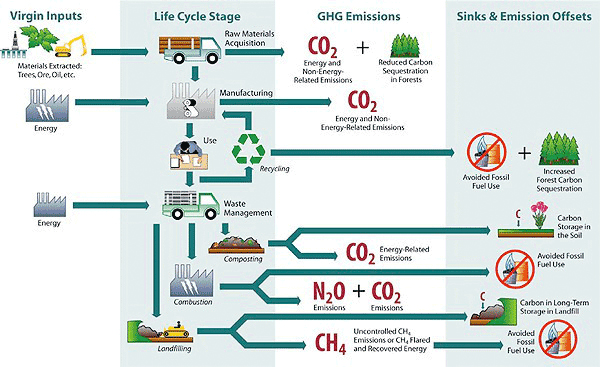
Image courtesy of the EPA
-
-
Scope 3 Reductions
-
Carbon Offset Projects
Funding of off-site renewable energy facilities, or purchasing renewable energy credits (RECs) of 100% green power energy, represent opportunities for buildings to further offset their carbon footprint through emission reductions at off-site locations. This will help to reduce the Scope 3 CO2 emissions. -
Wastewater Treatment and Solid Waste Reduction
The solid waste in landfills release methane from the anaerobic decomposition of organic materials. In buildings that contract out these duties to a 3rd party, any of the before mentioned reduction techniques will help to reduce Scope 3 CH4 and CO2 emissions as well as the energy needed to run these plants. Federal buildings can also further reduce these emissions by creating vendor requirements that include the most up to date management practices and/or facilities that use the waste to create an alternative fuel source, such as biomass or a combined heat and power plant. -
Travel and Commuting Reductions
Efforts to curb the amount of vehicle transportation will help to reduce Scope 3 CO2 emissions. This can be accomplished in a variety of ways including hosting an increased amount of teleconferences or Internet-based meetings, requiring the rental of hybrid vehicles by employees when traveling, and applying some sort of incentive, such as preferred parking to potential vendors when visiting the building in hybrid or other highly fuel efficient vehicles. Other measures include encouraging employees to carpool, use mass transit, bicycle, or walk when on business travel. Additionally, efforts should be made to select travel accommodations that are carbon neutral or that have a developed GHG reduction strategy. Measuring reductions can be challenging but can be accomplished with surveys and other estimating approaches. -
HCFC Reductions and Phase-outs
Replacing older refrigeration equipment or upgrading refrigerants such as R-22 in equipment with R-410A, will result in Scope 3 reductions due to the corresponding reductions throughout the product life cycle at locations such as production factories that are neither owned nor controlled by federal agencies. -
Purchased Energy Transmission & Distribution Reductions
The GHG emissions related to the energy losses and requirements associated with the transmission and distribution of purchased energy is a Scope 3 reduction. Therefore, any measure that can reduce the demand for an energy source will also reduce the emissions associated with its transmission. Additionally, federal buildings can incentivize those vendors that use transmission systems with energy recovery or high efficiency practices through vendor specifications or power purchase agreements. These losses often result in CO2 and fluorinated gas emissions.
-
D. Applicable Federal Regulation and Legislation as They Relate to GHG Reduction
-
-
This law directs all new Federal buildings—commercial or residential—to be designed 30% below ASHRAE standards or the International Energy Code. This will target emissions of all three Scopes.
-
It also includes renewable energy requirements governing the purchasing and use of renewable energy by Federal agencies and scheduled increase in renewable electricity consumption as well as incentives for on-site renewable electricity generation. This will target Scope 1 and 2 emissions.
-
-
Energy Independence and Security Act of 2007
-
Prohibits Federal agencies from acquiring any light-duty motor vehicle or medium-duty passenger vehicle that is not "a low greenhouse gas emitting vehicle." Alternatively, agencies may demonstrate that they have adopted cost-effective policies to reduce petroleum consumption sufficiently to achieve a comparable reduction in greenhouse gas emissions. This will target Scope 1 emissions.
-
Mandates energy reduction goals for Federal buildings and performance standards for new buildings and major renovations that will lead to greenhouse gas reductions due to the correlation between energy reduction measures and greenhouse gas emission reductions. This will target emissions of all three Scopes.
-
Applications
The following projects are good examples of GHG reduction technique implementation:
- Project highlights at the EPA Robert S. Kerr Environmental Research Center include:
- Retrofit project completed in 2006.
- EPA's first "carbon neutral" laboratory through a combination of green power agreements and high efficiency building construction.
- EPA offsets 100 percent of the electricity consumption with renewable energy certificates (RECs) purchased through the Agency's current blanket green power contract.
- Installed many high efficiency HVAC measures such as ground source heat pumps.
- A case study describing the retrofit project is also available.
- Project highlights at the Air Force Weather Agency Headquarters include:
- New Construction completed in 2008.
- U.S. Green Building Council LEED-NC, v.2/v.2.1—Level: Gold
- Energy efficiency measures in lighting, glazing, and cooling systems have resulted in the building using 50% less energy than a typical office building built to code (based on ASHRAE 90.1-2004).
- Reduced Scope 1 fluorinated gases and CFC emissions by using refrigerants that do not contribute to ozone depletion or global warming.
- Scope 3 CO2 and N2O reductions as areas on each floor are designated for collecting recyclables, and bulk-collection areas are provided on-site.
- Scope 3 CO2 reductions as more than 20% of the products specified were manufactured locally, including structural steel, metal decking, concrete, and face brick.
- Scope 3 CH4 reductions during construction, over 95% of the waste generated on-site was diverted from landfills, with a large percentage of this due to the reuse of the existing runway.
- Scope 3 reductions as preferred parking is provided for eco-friendly vehicles, and racks and shower facilities are available for bicyclists. Additionally, outdoor irrigation was eliminated by the selection of native and adapted plant species and indoor water use was reduced by more than 30% through the use of ultra-low-flow lavatory faucets and waterless urinals.
- Project highlights at the Arlen Specter Headquarters and Operations Center, Centers for Disease Control and Prevention include:
- New Construction project completed in 2006.
- Rating: U.S. Green Building Council LEED-NC, v.2/v.2.1—Level: Silver (33 points)
- Scope 3 reductions as the CDC encourages employees to access the campus via alternative transportation. The project includes bicycle racks as well as showers and changing rooms. The MARTA transportation system serves the campus, and CDC provides transportation subsidies to its employees. CDC also provides alternative fuel stations and reserves preferred parking for carpool vehicles.
- Scope 2 reductions as the building was designed to use 20% less energy than a comparable conventional building. More than half of the interior spaces use natural daylighting. Photo sensors and occupancy sensors turn off electric lighting when it is unnecessary. The building features heat-recovery ventilation as well as carbon dioxide monitoring and variable-volume air delivery. A building automation system allows staff to monitor and adjust the mechanical, lighting, and other systems to optimize efficiency and comfort.
Relevant Codes and Standards
- ASHRAE Standards
- Executive Orders
- Federal Codes
- Legislation
Additional Resources
U.S. Department of Energy (DOE) References
- Energy Efficiency and Renewable Energy—High Performance Federal Buildings Database
- Energy Efficiency and Renewable Energy—Renewable Energy Data Book
- Federal Energy Management Program—Purchasing Specifications For Energy Efficient Products
U.S. Environmental Protection Agency (EPA) References
- Greenhouse Gas (GHG) Emissions and Removals
- GHG Reduction Programs & Strategies
- Waste and Climate Change
U.S. General Services Administration (GSA) References
World Resources Institute (WRI) References
Tools
There are many tools and resources available for managing Federal building GHG emissions including the following:
- DOE Vehicle Fuel Economy: A DOE website with analysis tools for creating life cycle comparisons of vehicles.
- e-GGRT: EPA's GHG reporting tool.
- Federal Greenhouse Gas Accounting and Reporting Guidance : To view the established Government-wide requirements for measuring and reporting greenhouse gas (GHG) emissions associated with Federal agency operations.
- Federal Sustainability Progress, Plans, and Performance—Agency Progress Data, Annual Sustainability Report and Implementation Plans, and OMB Scorecards: View and explore interactive graphs on agency-specific progress on energy, water, renewable electricity, investments, fleets, and sustainable buildings.
- FEMP Annual Energy Management Data Report This Excel workbook (version 12-1) is the reporting instrument to use for comprehensive reporting of energy and water use, costs, square footage, and associated greenhouse gas data. This document is to be used by top-tier federal departments and agencies for reporting aggregated data for fiscal year (FY) 2021.
- Global Warming Potentials: For additional information about GWP values and associated lifetimes. (US EPA)
- U.S. Greenhouse Gas Inventory Report: 1990-2014: Provides a broad overview of all U.S. greenhouse gas emission sources and sinks, introduces key concepts, and discusses the primary drivers for changes in emissions.
- WRI Greenhouse Gas Protocol Calculation Tools: GHG Protocol tools enable companies and cities to develop comprehensive and reliable inventories of their GHG emissions, and help countries and cities track progress toward their climate goals.








